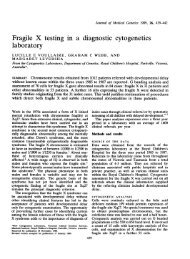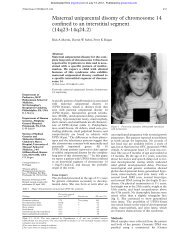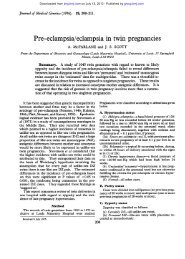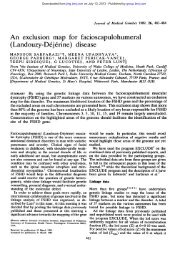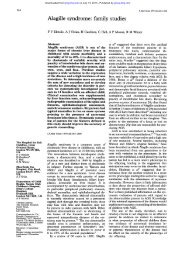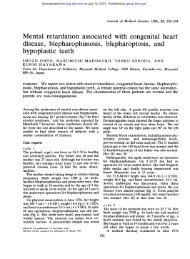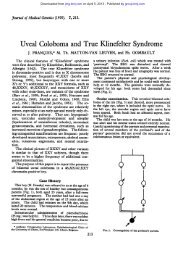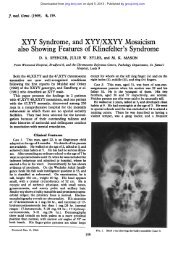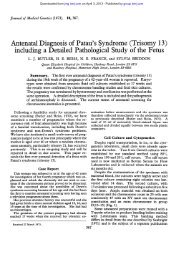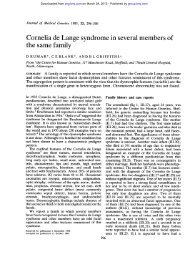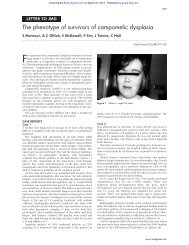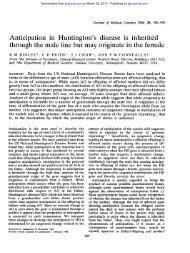Case reports - Journal of Medical Genetics
Case reports - Journal of Medical Genetics
Case reports - Journal of Medical Genetics
Create successful ePaper yourself
Turn your PDF publications into a flip-book with our unique Google optimized e-Paper software.
<strong>Case</strong> <strong>reports</strong><br />
<strong>Journal</strong> <strong>of</strong> <strong>Medical</strong> <strong>Genetics</strong> 1988, 25, 349-357<br />
A lethal short rib syndrome without polydactyly<br />
R M WINTER<br />
The Kennedy-Galton Centre for Clinical <strong>Genetics</strong>, Harperbury Hospital, Shenley, Radlett, Herts WD7 9HQ;<br />
and Division <strong>of</strong> Inherited Metabolic Diseases, Clinical Research Centre, Northwick Park Hospital, Harrow,<br />
Middlesex HAI 3UJ.<br />
SUMMARY A female infant is described with a<br />
lethal short rib syndrome, similar to a form <strong>of</strong><br />
short rib-polydactyly syndrome but without<br />
polydactyly. It is felt that this infant has the<br />
same condition as that described by Beemer<br />
et al.'<br />
Syndromes including short ribs represent a heterogeneous<br />
group <strong>of</strong> disorders. A subgroup consists <strong>of</strong><br />
those conditions which are or can be lethal at or<br />
I.<br />
I./<br />
-4~~~~~~~~~~~~~~~<br />
..2<br />
V,,,<br />
f $ Fr<br />
FIG 1 AP photography <strong>of</strong> the affected infant. Note relative<br />
macrocephaly, midline cleft upper lip, short limbs, and<br />
narrow chest.<br />
Received for publication 27 March 1987.<br />
Accepted for publication 27 April 1987.<br />
Downloaded from<br />
jmg.bmj.com on March 22, 2013 - Published by group.bmj.com<br />
before birth and these include thanatophoric dysplasia,<br />
achondrogenesis, Jeune syndrome, and the<br />
short rib-polydactyly syndromes. Beemer et all have<br />
described two patients with short ribs and early<br />
neonatal death. Although these infants showed<br />
similarities to some types <strong>of</strong> short rib-polydactyly<br />
syndrome, polydactyly was absent and it was suggested<br />
that they represented a new entity. A further<br />
female is described here showing greater similarity<br />
to the cases <strong>of</strong> Beemer et all than to any reported<br />
form <strong>of</strong> short rib-polydactyly syndrome.<br />
FIG 2 AP radiograph <strong>of</strong> affected infant. Note short<br />
horizontal ribs, highly placed clavicles, small scapulae and<br />
ilia, short tubular bones with bowing <strong>of</strong> radius and ulna,<br />
and minimal metaphyseal irregularity or spiking.<br />
349
350<br />
Downloaded from<br />
jmg.bmj.com on March 22, 2013 - Published by group.bmj.com<br />
<strong>Case</strong> report<br />
The female infant was the child <strong>of</strong> nonconsanguineous<br />
Caucasian parents. The mother had<br />
had one previous early miscarriage and there was<br />
one normal female sib. Delivery was by caesarian<br />
section at 38½/2 weeks because <strong>of</strong> polyhydramnios<br />
and a large head. At birth the baby weighed 3-5 kg,<br />
length 44 cm (98 centile). The limbs were markedly<br />
short with an arm span <strong>of</strong> 27 cm and a pubis to heel<br />
length <strong>of</strong> 13 cm. There was midline cleft upper lip<br />
and cleft palate with a very narrow thorax (fig 1).<br />
The digits were short, but there was no polydactyly.<br />
Radiographs showed very short, horizontal ribs,<br />
highly placed clavicles, small scapulae, small ilia,<br />
short tubular bones with bowing <strong>of</strong> the radius and<br />
ulna, and minimal metaphyseal irregularity and<br />
spiking (fig 2). Chromosomal analysis showed a<br />
normal female karyotype. Unfortunately cartilage<br />
histology was not examined and necropsy was not<br />
carried out.<br />
Discussion<br />
Although a diagnosis <strong>of</strong> one <strong>of</strong> the short ribpolydactyly<br />
syndromes manifesting without polydactyly<br />
must be considered here, this case is very<br />
similar to two unrelated cases, one born to a<br />
consanguineous couple, described by Beemer et al. 1<br />
These authors did consider the possibility <strong>of</strong> their<br />
cases being examples <strong>of</strong> a type <strong>of</strong> short ribpolydactyly,<br />
particularly type II (Majewski); however<br />
the radiological features were not consistent<br />
with this condition. In short rib-polydactyly syndromes<br />
I (Saldino-Noonan) and III (Verma-<br />
Naum<strong>of</strong>f), meta?hyseal irregularity and spiking is a<br />
marked feature. It was not present in the case<br />
described here, apart from possible mild irregularity<br />
<strong>of</strong> the distal end <strong>of</strong> the femora. Short ribpolydactyly<br />
syndrome type II (Majewski) characteristically<br />
manifests with hypoplastic, oval shaped<br />
<strong>Case</strong> <strong>reports</strong><br />
TABLE Common features in three reported cases.<br />
Present Beemer et all<br />
case<br />
<strong>Case</strong> I <strong>Case</strong> 2<br />
Macrocephaly + + +<br />
Flat face + + +<br />
Midline cleft lip + + +<br />
Cleft palate + +<br />
Ascites - + +<br />
Omphalocele - + +<br />
Narrow thorax + + +<br />
Short ribs + + +<br />
Highly placed clavicles + + +<br />
Small scapulae + + +<br />
Small ilia + + +<br />
Short tubular bones + + +<br />
Bowing radius/ulna + + +<br />
Metaphyseal irregularity/spiking +/- - -<br />
Family history Isolated Parents Isolated<br />
case consanguineous, case<br />
affected sib<br />
diagnosed<br />
prenatally<br />
by ultrasound<br />
tibiae,3 quite unlike the well formed tibiae seen in<br />
the present case. Thus, it seems possible that a<br />
separate short rib syndrome is being described. The<br />
common features are shown in the table. Inheritance<br />
is assumed to be autosomal recessive, because <strong>of</strong> the<br />
sib pair reported by Beemer et al.<br />
References<br />
Beemer FA, Langer LO Jr, Klep-de-Pater JM, et al. A new<br />
short rib syndrome: rcport <strong>of</strong> two cases. Am J Med Gentet<br />
1983;14: 115-23.<br />
2 Sillence DO. Non-Majewski short-rib polydactyly syndromc.<br />
Am J Med Genet 1980;7:223-9.<br />
3 Chen H, Yang SS, Gonzalez E, Fowler M, Al Saadi A. Short rib<br />
polydactyly syndrome, Majewski type. Am J Med Genet<br />
1980;7:215-22.<br />
Correspondence and requests for reprints to Dr R M<br />
Winter, The Kennedy-Galton Centre for Clinical<br />
<strong>Genetics</strong>, Northwick Park Hospital, Watford Road,<br />
Harrow, Middlesex HAl 3UJ.<br />
Intrauterine death in megacystis-microcolon-intestinal hypoperistalsis syndrome<br />
S A FARRELL<br />
Division <strong>of</strong> <strong>Genetics</strong>, The Credit Valley Hospital, Mississauga, Ontario, Canada L5M 2NI.<br />
SUMMARY Megacystis-microcolon-intestinal<br />
hypoperistalsis syndrome is an uncommon<br />
condition, possibly inherited as an autosomal<br />
recessive trait. This report describes an<br />
affected sib pair with intrauterine death <strong>of</strong> one<br />
<strong>of</strong> the sibs.<br />
Received for publication 1it March 1987. -<br />
Revised version accepted for publication 11 May 1987.<br />
Winter and Knowles' recently described the occurrence<br />
<strong>of</strong> megacystis-microcolon-intestinal hypoperistalsis<br />
syndrome in two female sibs who were the<br />
<strong>of</strong>fspring <strong>of</strong> first cousin parents, suggesting the<br />
possibility that this disorder has an autosomal<br />
recessive aetiology. Few cases <strong>of</strong> this condition,<br />
characterised by hypoperistalsis <strong>of</strong> the bowel and<br />
dysfunctional bladder contractility, have been reported<br />
and only three other possibly affected sib<br />
pairs have been noted.4 This report describes
Downloaded from<br />
jmg.bmj.com on March 22, 2013 - Published by group.bmj.com<br />
Email alerting<br />
service<br />
Notes<br />
A lethal short rib syndrome<br />
without polydactyly.<br />
R M Winter<br />
J Med Genet 1988 25: 349-350<br />
doi: 10.1136/jmg.25.5.349<br />
Updated information and services can be found at:<br />
http://jmg.bmj.com/content/25/5/349<br />
These include:<br />
To request permissions go to:<br />
http://group.bmj.com/group/rights-licensing/permissions<br />
To order reprints go to:<br />
http://journals.bmj.com/cgi/reprintform<br />
To subscribe to BMJ go to:<br />
http://group.bmj.com/subscribe/<br />
Receive free email alerts when new articles cite this<br />
article. Sign up in the box at the top right corner <strong>of</strong><br />
the online article.





